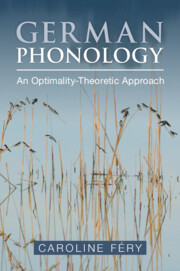Book contents
- German Phonology
- German Phonology
- Copyright page
- Contents
- Figures
- Tables and Tableaux
- Preface
- Abbreviations
- 1 Introduction
- Part I Lower Prosodic Constituents: Moras, Syllables, Feet
- Part II The Higher Prosodic Constituents: Prosodic Words, Prosodic Phrases and Intonation Phrases
- 7 The Prosodic Word
- 8 Prosodic Phrasing
- 9 Tones and Intonation
- 10 Conclusion and Survey of the OT Constraints Used in the Book
- References
- Index
- List of Constraints
9 - Tones and Intonation
from Part II - The Higher Prosodic Constituents: Prosodic Words, Prosodic Phrases and Intonation Phrases
Published online by Cambridge University Press: 04 January 2025
- German Phonology
- German Phonology
- Copyright page
- Contents
- Figures
- Tables and Tableaux
- Preface
- Abbreviations
- 1 Introduction
- Part I Lower Prosodic Constituents: Moras, Syllables, Feet
- Part II The Higher Prosodic Constituents: Prosodic Words, Prosodic Phrases and Intonation Phrases
- 7 The Prosodic Word
- 8 Prosodic Phrasing
- 9 Tones and Intonation
- 10 Conclusion and Survey of the OT Constraints Used in the Book
- References
- Index
- List of Constraints
Summary
Chapter 9 addresses intonation, the tonal melody that contributes to the interface between phonology, on the one hand, and syntax and semantics, on the other. It is shown how the φ-phrase and the ι-phrase are identified not only by their phrasing and their metrical structure but also by their tonal structure. These high-level constituents are the domains of assignment of intonational tones associated with stressed syllables and edges of φ-phrases and ι-phrases (i.e., pitch accents, phrasal tones and boundary tones). These tones form melodic tunes that deliver not only grammatical information but also pragmatic and so-called “paralinguistic” meanings.
Keywords
- Type
- Chapter
- Information
- German PhonologyAn Optimality-Theoretic Approach, pp. 388 - 427Publisher: Cambridge University PressPrint publication year: 2025

